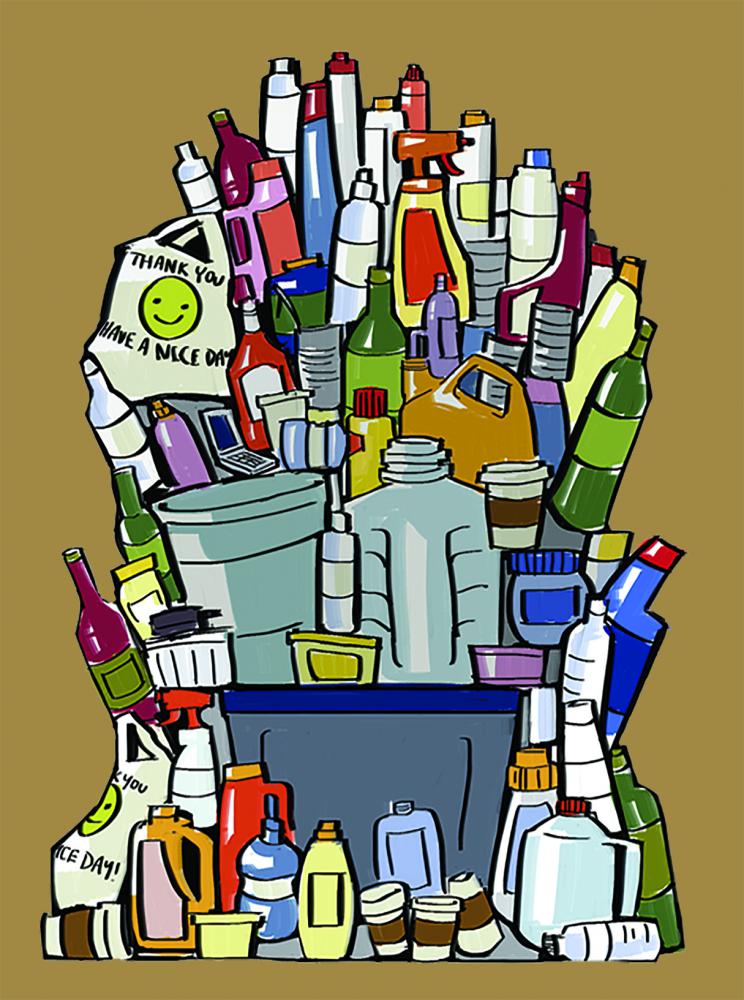Americans make tons of garbage. Actually, about 700,000 tons of garbage are produced each day according to EPA data for 2014. The U.S. has one of the highest rates of waste production per capita in the world, and it's widely recognized that this trend needs to end in the near future. But how did it begin in the first place?
American consumerism took off in earnest during the 1920s after factory lines, which had been mass producing machinery and supplies during World War I, shifted from military needs to consumer goods. Access to household electricity was on the rise at the same time, and standards of living for the average American began to rise rapidly. New inventions, once considered luxury items, began making their way into the homes of the general population. Radios, refrigerators and automobiles spearheaded the rise of a culture of consumption that has only intensified since.
Consumer culture has expanded to such a degree today that it has earned a new label in some circles: throwaway culture. An unfamiliar term to some, throwaway culture refers to the consumer society that would, rather than make repairs or reuse purchased items, cast them off.
“It’s not so much the throwaway aspect, but the [consumption] to start with,” said Dr. Gabrielle Gaustad, associate professor in the Golisano Institute for Sustainability (GIS).
A prominent example is cellphones. Instead of sticking to the same phone until it has crashed and there is no hope for its survival, people tend to jump at the release of the newest model.
“My opinion is really that it’s not so much the throwaway aspect, but the [consumption] to start with.”
“There is a huge throwaway culture," said TJ Fallon, a first year Electrical Mechanical Engineering Technology major. "There are a bunch of people who are sheep blindly following tech companies and they don’t care why it's new. It could be exactly the same thing that costs $500 more and people would still buy it and they would throw out their old phones.”
“New is better,” Fallon added.
Despite the growing trend to constantly upgrade, some students have not fallen under the smartphone spell.
“I have a dumb phone, as they call it, where you slide it and there’s a keyboard,” said Elijah Powell, a first year Mechanical Engineering major. Should he have to upgrade, he answered that he would get a smartphone. Were that to break, however, he wouldn't instantly discard it.
Whereas many people nowadays would use a shattered screen as an excuse to toss the old phone and get a new one, Powell said, “I would probably be like ‘dang it, this phone looks less good now.’ [But] you can replace a phone screen pretty cheap compared to getting a new phone.”
"A cracked phone to me is an opportunity to get a new phone, fix the old one, and use it for something else,” Fallon said.
Throwaway culture also refers to our tendency to simply discard unneeded or unwanted items with no regards as to what will happen to them after they leave the curb. It’s easy to toss something useless to us in a trash bag, tie it up, place it in a large bin and wait for it to be carted off. Around campus, students are confronted with options as to where to throw their trash: in the landfill bin or the recycling bin. Simply from observation, it seems that even though both bins are equally accessible, students typically opt for the landfill can.
“It’s always a complex question as to what you should do with materials when you’re done with them ... [People] don’t think about the end, like what’s actually going to happen to it,” Gaustad said.
Most don’t tend to realize the impact they are having on the environment when they throw something away rather than finding a way to reuse it.
“I think when it comes to environmental impacts, understanding and quantifying what [they] are is just so incredibly complex,” Gaustad said.
It wasn’t until more recently that the impacts of such mass consumption started being taken into account at a government level. Many states have implemented laws and programs to try and increase green living, New York state included.
The Solid Waste Management Act of 1988 states that one of the top priorities is to “reuse material for the purpose for which it was originally intended or to recycle material that cannot be reused.” However, one of the difficulties with reusing materials for their original purpose is that it’s quite difficult to get pure plastic from recycled materials.
"If you’re producing plastic from recycled plastic, you’re probably only saving 15 percent of the energy burden,” Gaustad said. “There’s not really strong economic incentive to use [it].”
New York State has taken aim at increasing those incentives with a program geared specifically toward plastic bottles, a major source of plastic waste. According to the Ban the Bottle organization, only 12 million of the 50 million bottles used in the U.S. per year are recycled, which means a whopping
RIT provides services corresponding to this bill with a little help from the community. The Bottle Return office is located in the tunnels underneath Sol Heumann Hall and is open Sunday and Thursday evenings from 6–9 p.m. Dean Engdahl, associate director of Dining Services East, mentioned, “We work with a local guy. He’s been [collecting the bottles at RIT] for like 30 years... He comes every week and picks [the bottles] up.”
As it has evolved from the beginnings of mass consumerism in the 1920's, throwaway culture has increasingly become the norm. However, society is beginning to push back as more and more people become aware of the problem. Gaustad believes patience will pay off.
"I think things are changing, it just takes a long time," Gaustad said.








